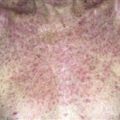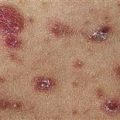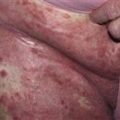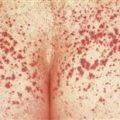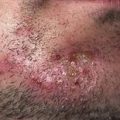55
Genital warts
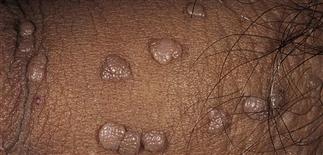
Small grouped verrucous papules on the penile shaft.
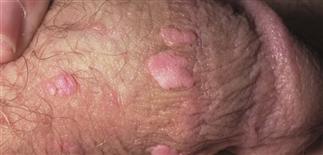
Genital warts are similar in appearance to common warts, with a pink to flesh-colored verrucous surface.
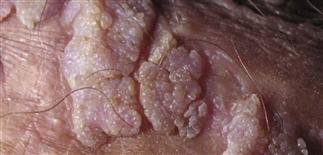
Multiple discrete warts on the shaft of the penis begin as barely raised papillomatous elevations and may coalesce into larger plaques.

Verrcous and filiform, pedunculated grouped papules and the perianal opening.
DESCRIPTION
Caused by infection of genital or anal skin by human papillomavirus (HPV). Warts in these locations can be difficult to eradicate, many are asymptomatic carriers, can lead to carcinoma. Variation in wart characteristics, recurrence, and response to treatment may relate to individual’s immune response. Common.
HISTORY
• Spread rapidly over moist areas; may therefore be symmetric on opposing surfaces of labia or rectum. • Frequently recur after treatment. • Latent virus exists beyond the treatment areas in clinically normal skin. • Half of patients who have widespread infection with genital HPV and who practice orogenital sex have oral condylomata. Lesions may be asymptomatic. Magnification may be necessary to detect oral lesions. • Genital warts in children may result from sexual abuse. A child with warts on the hands can transfer the warts to the mouth, genitals, anal area. A mother with hand warts can transfer warts to child. Sexual play among children another possible mode of transmission. • HPV types 16 and 18 most strongly associated with genital cancers.
PHYSICAL FINDINGS
• Lesions may vary by individual. Lesions tend to be pale pink to white, rough, barely raised papules. Others may have projections on a broad base. Surface may be smooth, velvety, and moist, and lacks the hyperkeratosis of warts found elsewhere. • Lesions may coalesce in the rectal or perineal area to form a large, cauliflower-like mass. • Warts may extend into the vaginal tract, urethra, and rectum, in which case a speculum or sigmoidoscope is required for visualization, treatment.
TREATMENT
• Warts that are flat and inconspicuous, especially on penile shaft and urethral meatus, can be difficult to visualize without magnification. • Treatment difficult; multiple visits and treatments often necessary for success. • Cryotherapy is most common initial therapy. Repeat treatment usually performed in 2–3 weeks. Treatment painful; blisters may form. When electrocautery and curettage used, a light touch with monopolar electrocautery, after anesthesia, is effective for treating a few isolated lesions. Scarring is possible with either treatment. • Imiquimod, Condylox, and Cantharidin all topical methods of wart removal but may require multiple applications and courses. • Use of condoms may reduce transmission to partners likely to be uninfected, such as new partners. • Over 90% of cervical carcinomas are related to HPV infection. For this reason, women who have no visible external warts but have a sexual partner with genital warts should have a complete gynecologic examination and Pap smear.

